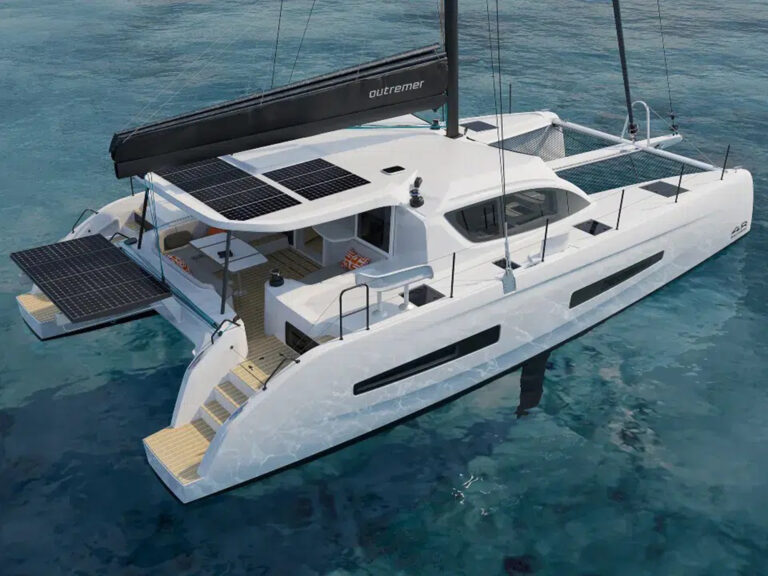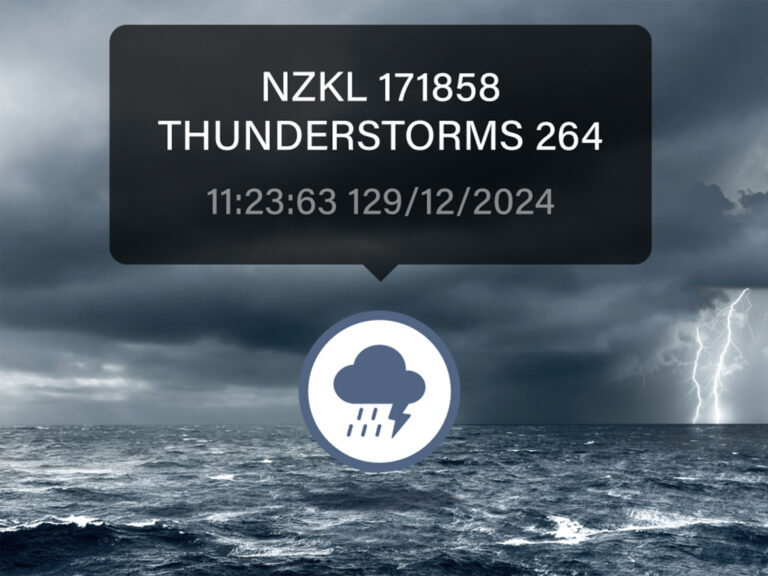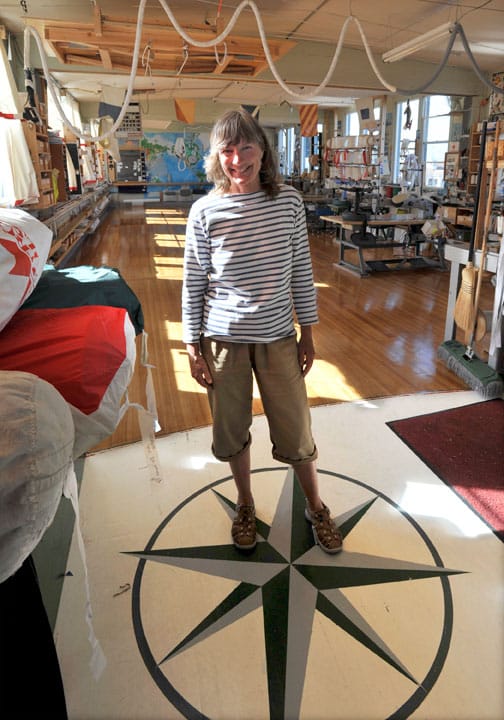
Carol Hasse
Recently, my wife, Diana, and I were anchored at Savai’i, an island in Samoa. Next to us swung Jenny P. III, a Hans Christian 33, the cruising home of a lovely family from Seattle. The boat was well equipped, well maintained and, albeit small, a responsible cruising vessel for taking Eric and Christine Larsen and their three young children safely across the Pacific Ocean.
Eric told me that when he was outfitting the boat, knowing that his kids would be on board, whenever he came across a decision that he felt in any way affected the safety of the vessel, he always chose the very best equipment available, regardless of cost.
I asked him what kind of sails he had. In a tone that implied that the choice went without saying, he said, “Carol Hasse sails.”
Technically, they’re Hasse and Company Port Townsend Sails, the company that Hasse (pronounced HA-see) founded and owns. But Eric Larsen can’t be faulted, because in this case, it’s hard to separate the sails from the sailmaker. Hasse’s work directly reflects her overall philosophy of life, and over her 35-year career as a sailor, sailmaker, teacher, and mentor, that philosophy has had a profound impact on the Pacific Northwest sailing community in general and Port Townsend, Washington, in particular.
Hasse is a founding member of the famous Wooden Boat Festival, Port Townsend’s signature annual event that’s now in its 36th year, a past board member of the Northwest School of Wooden Boat Building, a board member of the Northwest Maritime Center and the Wooden Boat Foundation, a three-time judge for Cruising World‘s Boat of the Year contest, a judge at the Victoria Classic Boat Festival, a nationally known seminar speaker, a volunteer on the sail-training vessels_ Alaska Eagle_ and Adventuress, and involved in too many other sailing and civic events to list here. She’s a perpetual-motion machine, a goodwill ambassador for anything that floats, an energetic activist and organizer, and a selfless volunteer.
It was this body of work that drew my interest and compelled me to sit Hasse down for two solid hours—no easy task, but I brought a rope—to record and report on her life of adventure and service.
As Fate Would Have It
Sailing would’ve missed out on one of its true luminaries had Hasse followed her obvious path in life. The oldest of four children, she grew up on the Columbia River Gorge in eastern Washington. Because of her early interest in social service and obvious academic acumen (she was awarded the coveted National Merit Scholar status), she and her entire family assumed that she was on her way to medical school via the University of Puget Sound.
But she also showed strong talents in athletics and an abiding interest in the outdoors. She bridled at the notion that she was incapable of accomplishing any outdoor feat simply because she was a girl, and she set her sights on hiking the Pacific Crest Trail and climbing 14,409-foot Mount Rainier. She knocked them both off with her customary determination.
She entered university at the height of the Vietnam War and was carried away on the ambient wave of radical idealism. She embraced pacifism, civil protest, vegetarianism, and such esoteric studies as Sufi dancing. Many did. The difference with Hasse was that she wasn’t following a fashion or bending to peer pressure; she was shaping a world outlook that defines her life to this day.
One year of classroom restraint was all she could take. She set off to hitchhike across the world on an adventure that took her from the tame art galleries of Europe to the lawless lands of Iraq and Syria.
When she finally returned home, she’d become an inveterate traveler, and although she re-entered college, she knew that she’d never be able to settle down into a conventional life.
Serendipity intervened in the form of an invitation to join friends of her family on board a Cascade 42 for an extended cruise in Mexican waters. She walked out of the classroom, down the dock, and hasn’t looked back since.
If her first dive into pristine tropical waters didn’t seal her fate, then her first moonlit night watch did. On that ocean, she found the heady freedom and the physical, intellectual, and spiritual challenges for which she longed.
As her host’s voyage neared an end, Hasse met some young sailors from another vessel. They were hoping to head for the Pacific Islands but had doubts as to their ability to celestial navigate. Confident, bright, and quick to learn, Hasse signed on as navigator. It was a proud moment when the Hawai’ian Islands appeared over the horizon exactly when and where she’d calculated.
One boat led to another. She’s sailed on Chinese junks, monohulls, and multihulls ranging from 25 to 101 feet and made from wood, steel, fiberglass, and ferro-cement. The boats and crews may have varied, but the central theme didn’t: her love of the sea and grand adventure.
As her exposure to sailboats increased, so, too, did her fascination with their design and construction. She determined that she wanted to become a wooden-boat builder, as she had an affinity for the material and an inclination toward the traditional. She fell into a communal schooner-building project in California, where she was handed the responsibility of making the sails.
She set off to meet Franz Schattauer, a master sailmaker in the old-world tradition. Schattauer taught Hasse sailmaking from the ground up: old-fashioned splicing, hand-sewn grommets, bulletproof reinforcing, leather finishing. He was a guildsman, and he’d abide no shortcuts. There would be nine stitches per needle length. Not eight, which is weak. Not 10, which unnecessarily perforates the fabric.
Hasse then went to work for Ron Harrow, who owned the only sail loft in Port Townsend. Here she made the sails for her communal schooner project and others. Although her interest in wooden boats didn’t wane, she discovered that the sailmaking segment of the industry was cleaner, quieter, and got her out on the water a lot more often than boatbuilding did. Also, she grew tired of the confusion inherent to communal projects, and she vowed that one day she’d own her own loft and her own boat.
When Harrow decided to take off, leaving the loft empty, Hasse thought, “Now’s my chance.” She sold her shares in the schooner and in 1978, with her friend, Nora Petrich, established Port Townsend Sails. It was a humble start. Initially, they had but a single sewing machine. For two and a half years, Hasse slept under the cutting table. But a loan of $5,000 allowed them to add machinery and hire two more employees. She eventually bought out Petrich’s share and became the sole proprietor of her own business.
Change and Challenges
It was a time of enormous change and cutthroat competition in the sailmaking industry. Lofts were modernizing and mechanizing with computer design and cutting machines. The bottom line demanded that new materials be thrown together in more expedient ways. There was little demand and less profit for sails made in the painstaking manner of the past, but Hasse remained committed to Schattauer’s philosophy: “Give it the same love that a fine shipwright would give the woodwork.”
At first her reputation as a traditionalist drew only the classic-boat enthusiasts, big schooner projects, and historic recreations. But with time, it became apparent that although a little more expensive due to all the handwork and attention to detail, a Hasse sail stayed the course whether flown in tranquil local waters or in the far-flung corners of a windy world.
Her commitment to quality paid off, and the business grew. As she expanded the loft to 10 employees, she had to reconcile her own liberal philosophies with the harsh realities of capitalism. She determined that she’d live out loud the philosophies she held and implemented extremely progressive programs of profit sharing, flextime, maternity leaves, “health days” instead of “sick days,” up to four weeks of paid vacation, and the like.
Those practices created an atmosphere of trust and respect at P.T. Sails, and that’s translated into an efficient and committed workforce, some of whom have been on the team for up to 25 years.
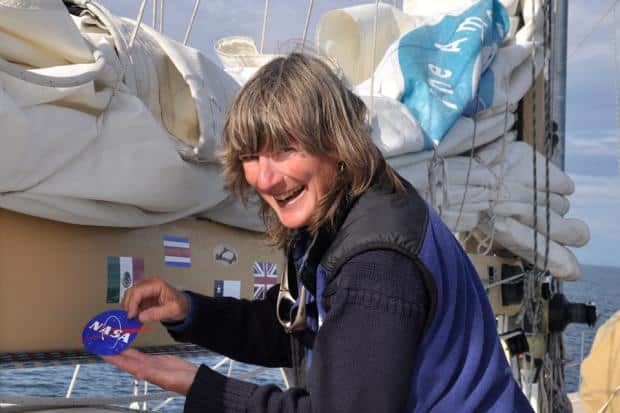
Hasse’s loft built the sails that took Ocean Watch on its journery around the Americas. Carol joined the crew for their last leg home to Seattle.
The loft builds 100 to 150 sails per year, mostly for vessels measuring 35 to 55 feet in length, but with occasional projects for boats up to 100 feet. Port Townsend sails have traveled to the ends of the planet, including on the recent Around the Americas expedition on Ocean Watch, which was chronicled in Cruising World by crewmember Herb McCormick, now the magazine’s senior editor.
Hasse doesn’t get her hands on a sewing machine much any more. She insists, however, on personally measuring up every boat that places an order with P.T. Sails. This keeps her out on the water and out of the loft for much of the time. She’s had opportunities to expand into additional lofts in San Francisco, British Columbia, and Hawai’i, but decided that if she’s to remain personally involved with every sail that comes out of her loft, she must remain small.
She came to the same conclusion with regard to the boat that she’d been promising herself. Her friend, Suzanne Abbot, who in the 1980s became the first female commodore of San Francisco Bay’s Master Mariners Benevolent Association, told her, “All boats are too big on the outside and too small on the inside.”
Taking that advice to heart, she fell in love with Lorraine, a lapstrake 25-foot Nordic Folkboat built in Denmark in 1959. Lorraine sits in the Point Hudson Marina, just below the P.T. Sails loft. Whenever Hasse has time to look up from her desk, which isn’t often, the sight of the lovely sloop puts a smile on her face.
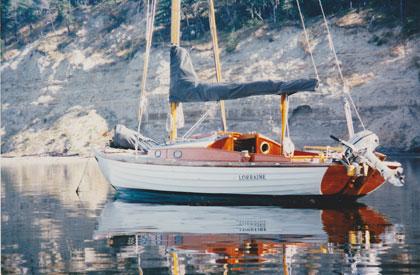
When not sailing aboard others’ boats, she explores the Pacific Northwest on Lorraine, her 25-foot wooden Nordic Folkboat.
Lorraine is elegantly simple and simply elegant. Hasse absolutely lavishes her with loving care. Every year Lorraine carries Hasse and her teenage son, Grayson—he’s named after the American merchant sea captain Robert Gray, who named the Columbia River—through the local waters of Puget Sound and farther afield into the scenic backcountry of British Columbia.
Place to Call Home
Initially, Hasse thought that she’d committed herself to a life of wandering, and with 45,000 sea miles under her keels she’s done her share. But in the small village of Port Townsend, she found more than a boat and a business: She found a home.
And when Hasse commits to something, things get done. She’s held the position of secretary on the board of the Wooden Boat Foundation, which runs the Port Townsend Wooden Boat Festival, for 33 years. This festival has grown into a national event and has been the centerpiece of the expansion of Port Townsend from a languishing old whaling town into a vibrant new maritime and tourist destination. In addition to her other board and association work, in her “spare time” she’s used her American Sailing Association certificate to teach sailing to young women on board such training ships as Alaska Eagle, earned a U.S. Coast Guard 100-ton captain’s license, and lectured at women’s sailing seminars in Seattle. Add to this a busy schedule of participation in the Shoreline Advisory Committee and her involvement with various other local political, social, and environmental issues, and—well, you get the picture.
Racing to keep up with Hasse and bring some order to both her business and her life is her partner, Nicki Hopkins, who joined P.T. Sails nine years ago. Although technically the office and personnel manager, Hopkins has dubbed herself the “Chaos Manager.”
I asked Hopkins how she pulls together all of Hasse’s frenetic energy and diverse interests and commitments into something cohesive.
She smiled and said, “Hasse’s the boss, and I’m bossy.”
So while Hasse is out measuring sails, in a civic meeting, or flying off to Fiji to volunteer on an all-women’s sailing vessel, Hopkins sits at the fiscal helm of P.T. Sails. It’s a partnership that works well to the benefit of customers and community.
As I was packing up my tape recorder and notebook, Hasse dashed up to the second floor of her lovely home on Discovery Bay, which was built via barter with local shipwrights, to quickly pack in time to catch the ferry to Victoria, British Columbia, to measure up a boat for a potential customer and hammer down the final details concerning the upcoming Classic Boat Contest. She also hoped to squeeze in a talk with the captain of a Canadian coast-guard icebreaker who suspects that he might have found the location of some remains of the doomed 1845 Sir John Franklin Arctic expedition, for Hasse is interested in all things historical and all things nautical.
As Hasse dashed out the door, she pointed to her cellphone, shorthand directed at Hopkins to mean “We’ll talk.”
Hopkins shook her head, smiled, and said, “There goes the Hasse.”
Alvah Simon is a CW contributing editor.






